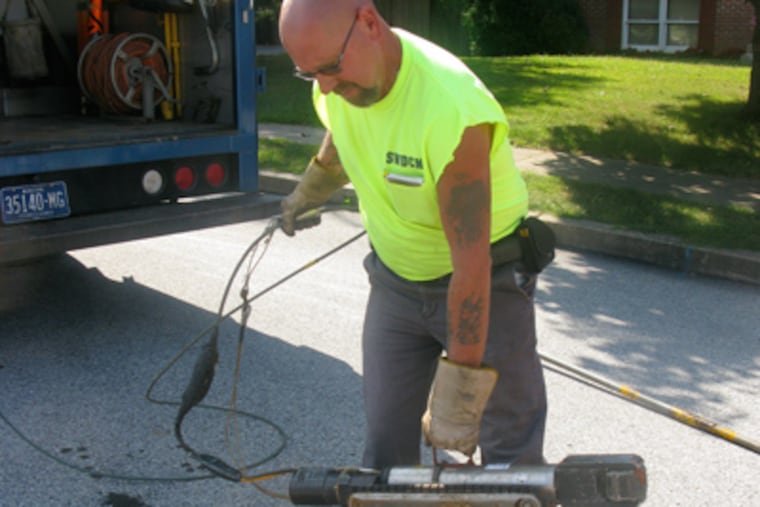Hidden treasure in Philadelphia-area sewers
The two men - sewer workers - never know what they might find in a day's work. So it was with a bit of expectation that they recently snaked their robotic camera down into a manhole, looking for cracks and water leaks in the sewer pipes.

The two men - sewer workers - never know what they might find in a day's work.
So it was with a bit of expectation that they recently snaked their robotic camera down into a manhole, looking for cracks and water leaks in the sewer pipes.
Andrew Brzezicki and his partner, Larry Fisher, both with the Southwest Delaware County Municipal Authority, flushed the lines with a high-pressure water hose to clean them, sifted out grit caught in a screen, and then began to look.
Most evident were the usual globs of shiny orange-colored grease - a homeowner's nightmare when it clogs a pipe.
But it is the other stuff they occasionally encounter that can make their day.
"You have to be at the right place at the right time," said sewer maintenance supervisor Brzezicki as he carefully maneuvered the camera angle from a computer monitor inside his specially equipped truck.
"Anything you flush down the toilet can wind up down here."
"Anything" can include gold bracelets, diamond rings, and cash.
Yup. Bling.
"A lot of gold," said L. Fernando Baldivieso, director of public works in Upper Darby.
Well, not a basket of bling.
In Aston, with 82 miles of sewer lines, the crew's payload is about $10 in change every month, said Brzezicki, a 15-year employee. About once every two months a worker will find a piece of jewelry - though mostly costume.
Most sewer departments have a finders-keepers philosophy.
"If the guy is willing to reach in and grab it, it is his," said George Crum, director of the Southwest Delaware County Municipal Authority, which serves parts of lower Delaware County, including Aston, Middletown, Chester Heights, and Upper Providence.
Bracelets, diamond rings, money, toothbrushes, cell phones, dog bones - and even two guns recovered after a burglary - have been known to make their way into the Radnor Township sewers, said Mark Domenick, sewer supervisor.
"We are on call 24/7, 365 - every day," he said. "Kids will throw anything down a hole."
"We've had ducks," Domenick said. "We go rescue them. We get a lot of them."
Are there alligators?
"There could be," said Tom Ferguson, plant manager at the Philadelphia's Southeast Wastewater Treatment Plant. "People get tired of pets, and they just take them to the creek."
Mostly, he said, Philadelphia sewer workers see trash - plastic bags, Budweiser cans, Wawa cups, candy wrappers - and catfish that swim into the plant during heavy rains. Occasionally a wad of well-worn bills will get trapped in a grate used to filter out the trash. The found money gets spent treating coworkers to lunch.
After one memorable catch 15 years ago, Philadelphia sewer workers added a member, of sorts, to their staff.
Wes Smith, now 55, was busy working near the bar screens, the device that catches larger trash items, when he looked up and saw a foot-long snake coiled around a pipe.
"I didn't mess with him," Smith said. "I wasn't getting close."
"Curly," as the ball python was christened, was captured, given a bath, and now sleeps in a large terrarium, acting as an ambassador in the facility's educational department of the treatment facility on Pattison Avenue. When grade schoolers and tour groups ask what items workers find in the city's 2,960 miles of sewer pipes - some large enough to walk through - they are introduced to the now over four-foot-long reptile.
"He has more time in than most of the employees," said Joe Davis, 54, a treatment-plant operator at the facility. A couple of heat lamps and a white rat from a pet store now and then are all it takes to keep him happy.
Across the river and downstream from the Camden County Jail, sewer workers pulled out a 40-foot braided rope made of torn bedsheets and T-shirts in September 2008, according to Larry Coslow, the assistant project manager for United Water Environmental Services.
"We were wondering what was clogging up one of the sewers," Coslow said. Workers, he said, came up with a number of theories, including using the rope for escape or to hide contraband in the pipes.
What ends up in area creeks, especially if the article is light enough to float, can end up at water-treatment plants.
Crum said hundreds of small Nerf footballs used by a pizza company as a promotion floated into Aston sewers a few years ago. It was a marketing attempt gone bad.
Often, when rings or bracelets are recovered in the screens, Crum said, they are so "beat up" by their journey that they are unrecognizable and are sold to jewelers as scrap.
If the coins are old or unusual, workers will take them in for appraisal to see if they are valuable.
"And, sometimes, they are just spent in the vending machine," Crum said.
But cash finds in Philadelphia are waning, Davis said. Once people started using credit cards for even small purchases, he noted, the cash haul dropped off.
In Aston, Brzezicki remembers finding a 40-year-old class ring, minus the stone. With a bit of research he was able to locate a grateful owner.
Such finds are rare, he said. Only a few times in his career of 34 years has he discovered valuable jewelry.
But Brzezicki and Fisher did turn up one small thing of value when they inspected the sewers on Joanne Drive.
A dime. Battered and tarnished.